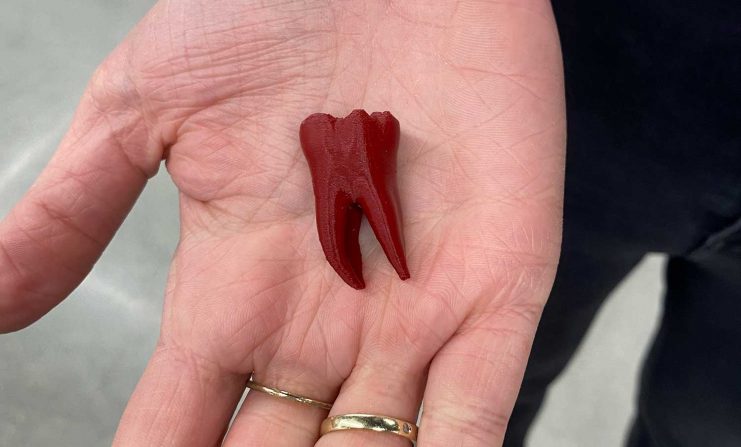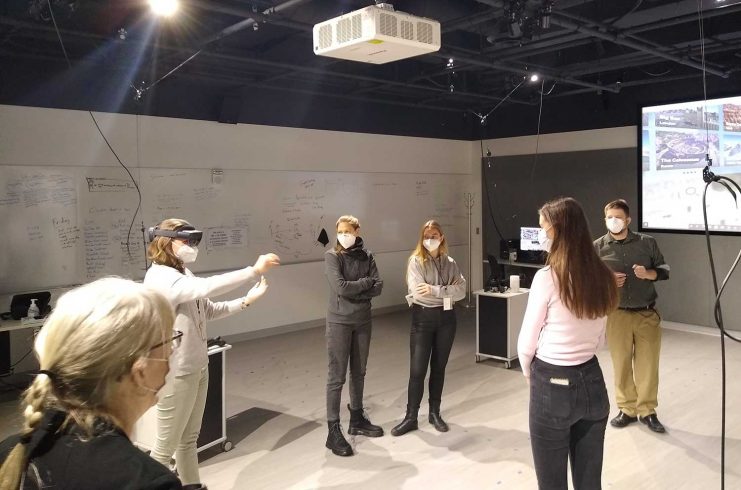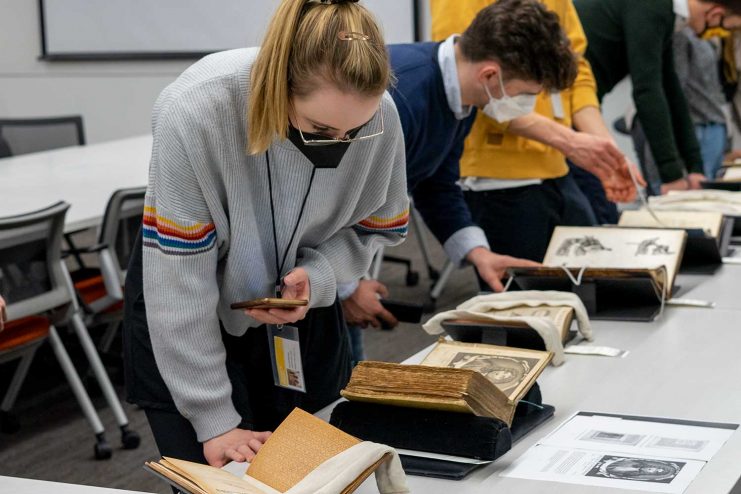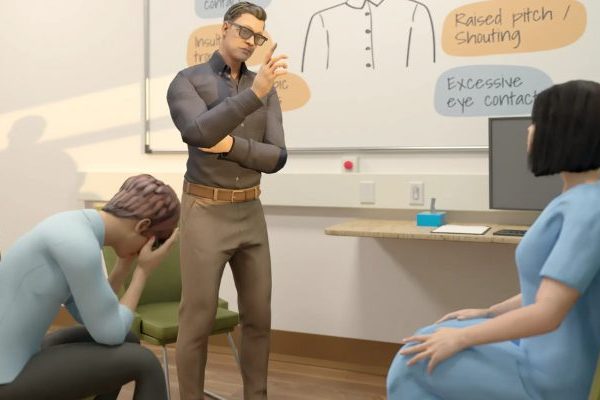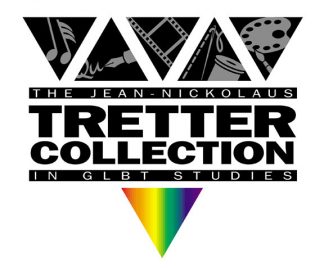By Allison Campbell-Jensen
Photographs by Allison Thompson
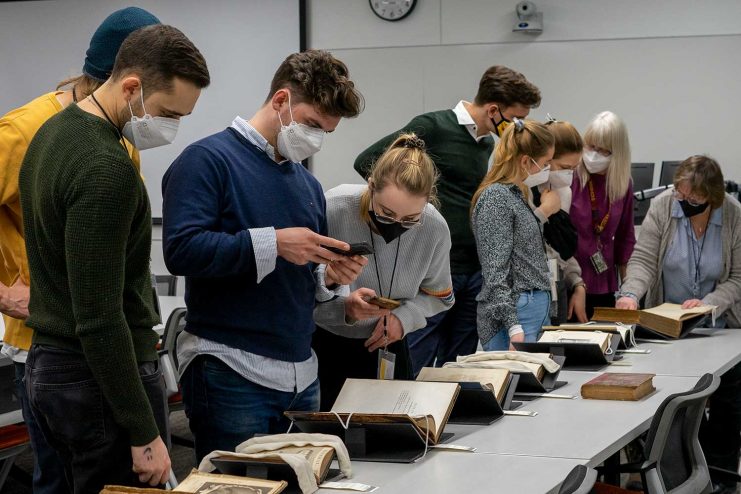
Heidelberg students examine rare books from the Wangensteen Historical Library of Biology and Medicine.
Hospitality to visitors from afar may include a gift bag of treats. For German students of dentistry from Heidelberg University, those treats included an introduction to the jaw-dropping high-tech in the Health Sciences Library and the history-rich learning environments in the Wangensteen Historical Library of Biology and Medicine.
Helping to arrange this exciting introduction to dental instruction in the United States was Nicole Theis-Mahon, liaison librarian for the University of Minnesota School of Dentistry. She was joined by Wangensteen Library Curators Lois Hendrickson and Emily Beck, whom Dr. Karin Quick credited with curating “an amazing exhibit with discussion drawing from their archives and focused on dentistry, healthcare, and Germany — including artifacts specific to these areas.” Quick is the School of Dentistry’s Director of Global Programs.
“What they created told a great story and prompted ideas and questions relevant to practice in today’s world,” she added. The experience of seeing older German texts in the Wangensteen Library prompted a student from Germany to ask: “What are you doing with all our books?” Quick notes that Heidelberg University, founded in 1386, does not have a similar historic archive.
Another student from Heidelberg noted on a feedback form from the visit to Wangensteen that it’s “great to see how much time and effort people spent in the past to transfer knowledge to us.” And that, of course, is just a portion of the University of Minnesota Libraries’ responsibilities and services to students, researchers, and scholars that the exchange program was able to take advantage of.
Learning together, online and then IRL
Since January 2022, 10 students from the University of Minnesota and 12 students from Heidelberg have taken part in the exchange program virtually. Using the high-tech communication capabilities offered in the Health Sciences Education Center, the students met remotely once per month to network, discuss cases, and learn from one another.
Atlanta Roloff, DDS ’22, said the exchange “opened my mind to the fact that there are so many ways to approach every situation, and the more ways I can learn, and the more people I can find to teach me their perspectives, the better dentist I will become.”
During their in-person visit, the exchange students from Heidelberg engaged in conversation with personnel from 3M based both in St. Paul and at a facility in southern Germany. They had gathered in The Commons, a new interprofessional space in the Health Sciences Library (HSL), which features a mini active learning classroom, where people can connect virtually and in-person to enhance teaching, learning, outreach and clinical practice.
During the session with 3M experts, the students were able to compare notes on practice in the United States and Germany. They also learned about 3M’s approach to oral health, one of the corporation’s major specialities.
The students from Germany visiting the School of Dentistry enjoyed the immediacy of conversation with those far-off instructors because of the high-tech learning environment offered by the Health Sciences Library in the Phillips-Wangensteen Building. It was Theis-Mahon who had suggested meeting these far-flung experts in The Commons.
A worthy mission
The mission of this exchange between the University of Minnesota and Heidelberg University’s dental programs goes beyond improving dentists of the future. As Dr. Jakub Tolar, Dean of the University of Minnesota Medical School, noted in a November 2021 newsletter, the U’s School of Dentistry has been making an impact by engaging in virtual exchanges with schools in Germany, Slovenia, and South Africa.
“These efforts demonstrate our ability to find creative solutions to stay connected to one another despite the challenges that come our way,” Tolar wrote. “Whether we are speaking of the pandemic, climate health, or humanitarian efforts, our fates — that of the world and all its living inhabitants — are intertwined.”
Intersecting at the Libraries
In the Makerspace, they could try 3-D printing and other hands-on learning experiences. The students also delighted in HSL’s Virtual Reality studio, which gave them a fresh look at anatomy through VR headsets and sophisticated software.
“This speaks to my strength of seeing connections between dental education, the Makerspace, Virtual Reality, the rare and historical collections of the Wangensteen, and also the new technology spaces in the library,” Theis-Mahon says. “I can see relationships, interests, or intersections between different things. This experience was beneficial for me, too,” because she recognized the power of building these connections for students.
The Heidelberg students were surprised, Theis-Mahon says, that the School of Dentistry has a dedicated liaison librarian, whose work is integrated into several of their courses. “When I was telling them how I support research or offer consultations with students, a few of the students, jokingly, asked if they could contact me if they had a question about a literature search.”
It’s “great to see how much time and effort people spent in the past to transfer knowledge to us.”
—Visiting dentistry student from Heidelberg University, about the Wangensteen Library collection.
According to Dr. Sven Gorr, who recently served as the Interim Associate Dean for Academic Affairs in the School of Dentistry, the German students of dentistry also were impressed by the amount of space and the quality of the facilities that University of Minnesota students have for hands-on learning about how to become dentists.
“We consider Moos Tower old and past its time,” he adds, “but they thought it was a great facility.” The U of M graduates 70% of Minnesota’s dentists.
The exchange this spring, based on a 25-year relationship between the two schools of dentistry, was especially exciting because the students had already begun meeting remotely. To see each other in person, after the two years of pandemic lockdown, and getting to know each other in three-dimensional space, was a thrill.
For extracurricular activities, a Gopher men’s hockey game was the highlight for one dental student visiting from Heidelberg. Well, of course, says Gorr: “You’re in the State of Hockey; you want to see a hockey game.”
Other exchange students were excited to meet with Minnesota state legislators on the floor of the Capitol in St. Paul. And, during a tour of the historic health care artifacts in the Wangensteen Historical Library, a few stopped in front of a 19th-century tooth extraction tool, made of wood. One asked: “Is this for a person … or a horse?” (As it turned out, the latter.)
Different continents, different approaches
Human teeth may be the same all over the globe, but oral health care differs somewhat in Germany and the United States — they may use different materials for fillings, or have a different preparation for patients who will undergo oral surgery, notes Gorr. The education of dentists also is not exactly the same: “They have more of a pressure to produce and work with patients than we do.”
In one way, however, he finds all the students similar. “They have the enthusiasm and thirst for learning that all students have,” he says. “That’s one of the things that makes working at the U fun.”
And, with the partnership of the Libraries and the expertise of its staff, they can always stay connected.


